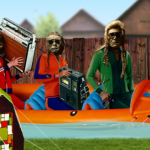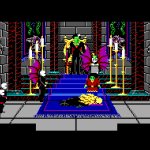Gravity Bone (2008)
January 15, 2009 - Features
 Recently I found myself wondering what a surrealist game would be. It’s a bit of a funny question, because all videogames are pretty surreal. There’s weird logic, weird environments, weird constraints on your behavior – everything in games is kind of like reality, but a bit off. You jump, and it’s kind of like jumping, but you jump way too high and can change direction in midair. You’re kind of in control of yourself, but not totally. And the rules change with every boss battle. If surrealism in art is about capturing a dreamlike atmosphere, well, most games are pretty dreamlike to some degree. It doesn’t make sense to talk about a specific game being surreal when the whole medium is.
Recently I found myself wondering what a surrealist game would be. It’s a bit of a funny question, because all videogames are pretty surreal. There’s weird logic, weird environments, weird constraints on your behavior – everything in games is kind of like reality, but a bit off. You jump, and it’s kind of like jumping, but you jump way too high and can change direction in midair. You’re kind of in control of yourself, but not totally. And the rules change with every boss battle. If surrealism in art is about capturing a dreamlike atmosphere, well, most games are pretty dreamlike to some degree. It doesn’t make sense to talk about a specific game being surreal when the whole medium is.
But the description seems to fit Brendon Chung’s Gravity Bone. Perhaps this is because Gravity Bone is kind of like other games, but a bit off. It’s using the classic Quake engine, so the mechanics are really familiar, but you use them to do ungamelike things, like looking at a business card. And while the graphics are displayed in classically lit 3D, they recall 8-bit design in their awkward blockiness. And you’re pursuing missions by following steps, like in a normal game, but the missions flagrantly make no sense and there aren’t enough of them for you to get the hang of the game’s rhythms.
Reviewers of Gravity Bone have expressed disappointment at the game’s short length, but that abrupt ending has a lot to do with the strange feeling the game leaves behind. And of course, it’s one more way that it’s kind of like a normal game, but not. Evoking videogame conventions without carrying them through normally is what Gravity Bone does, and what makes it so pleasantly disquieting.


